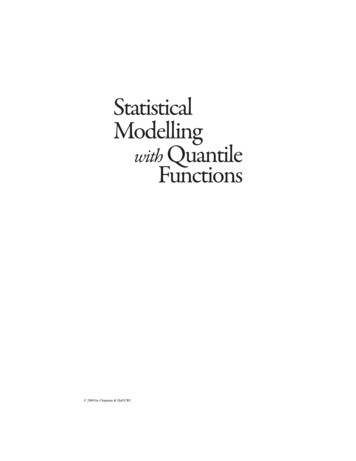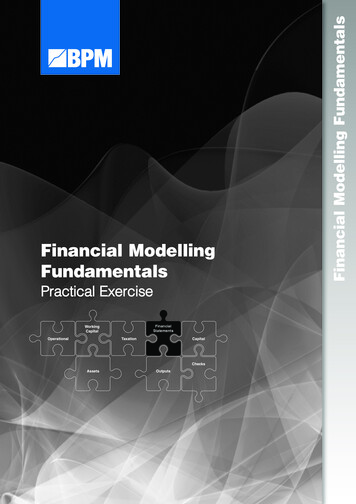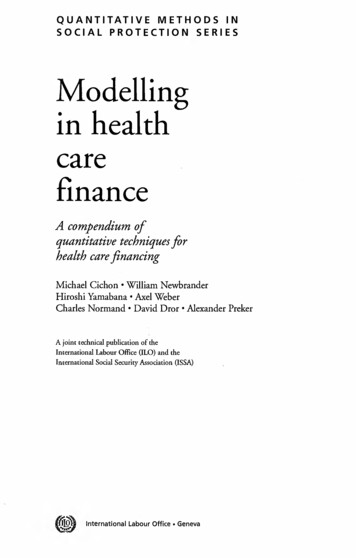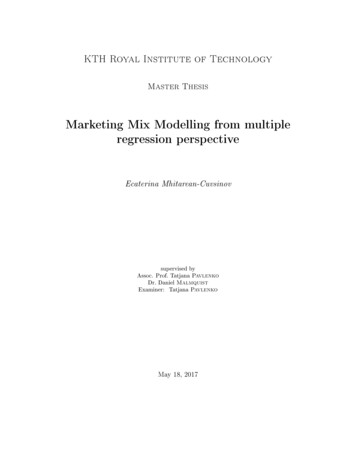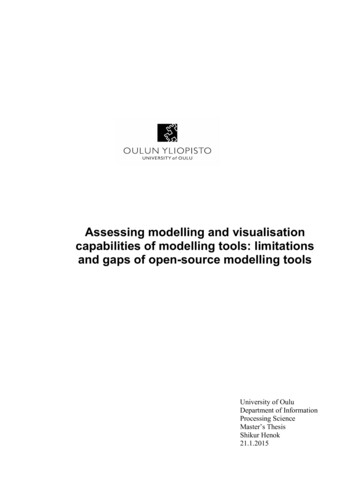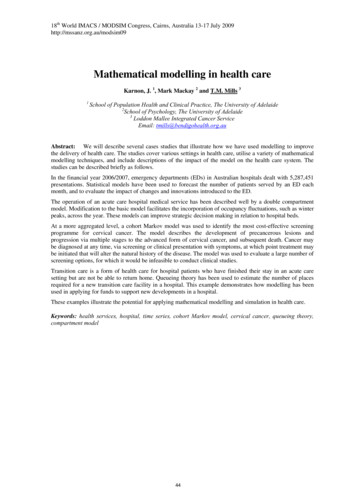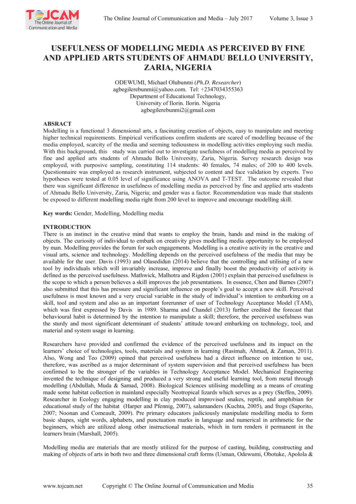
Transcription
The Online Journal of Communication and Media – July 2017Volume 3, Issue 3USEFULNESS OF MODELLING MEDIA AS PERCEIVED BY FINEAND APPLIED ARTS STUDENTS OF AHMADU BELLO UNIVERSITY,ZARIA, NIGERIAODEWUMI, Michael Olubunmi (Ph.D. Researcher)agbegilerebunmi@yahoo.com. Tel: 2347034355363Department of Educational Technology,University of Ilorin. Ilorin. Nigeriaagbegilerebunmi2@gmail.comABSRACTModelling is a functional 3 dimensional arts, a fascinating creation of objects, easy to manipulate and meetinghigher technical requirements. Empirical verifications confirm students are scared of modelling because of themedia employed, scarcity of the media and seeming tediousness in modelling activities employing such media.With this background, this study was carried out to investigate usefulness of modelling media as perceived byfine and applied arts students of Ahmadu Bello University, Zaria, Nigeria. Survey research design wasemployed, with purposive sampling, constituting 114 students: 40 females, 74 males; of 200 to 400 levels.Questionnaire was employed as research instrument, subjected to content and face validation by experts. Twohypotheses were tested at 0.05 level of significance using ANOVA and T-TEST. The outcome revealed thatthere was significant difference in usefulness of modelling media as perceived by fine and applied arts studentsof Ahmadu Bello University, Zaria, Nigeria; and gender was a factor. Recommendation was made that studentsbe exposed to different modelling media right from 200 level to improve and encourage modelling skill.Key words: Gender, Modelling, Modelling mediaINTRODUCTIONThere is an instinct in the creative mind that wants to employ the brain, hands and mind in the making ofobjects. The curiosity of individual to embark on creativity gives modelling media opportunity to be employedby man. Modelling provides the forum for such engagements. Modelling is a creative activity in the creative andvisual arts, science and technology. Modelling depends on the perceived usefulness of the media that may beavailable for the user. Davis (1993) and Olasedidun (2014) believe that the controlling and utilising of a newtool by individuals which will invariably increase, improve and finally boost the productivity of activity isdefined as the perceived usefulness. Mathwick, Malhotra and Rigdon (2001) explain that perceived usefulness isthe scope to which a person believes a skill improves the job presentations. In essence, Chen and Barnes (2007)also submitted that this has pressure and significant influence on people’s goal to accept a new skill. Perceivedusefulness is most known and a very crucial variable in the study of individual’s intention to embarking on askill, tool and system and also as an important forerunner of user of Technology Acceptance Model (TAM),which was first expressed by Davis in 1989. Sharma and Chandel (2013) further credited the forecast thatbehavioural habit is determined by the intention to manipulate a skill; therefore, the perceived usefulness wasthe sturdy and most significant determinant of students’ attitude toward embarking on technology, tool, andmaterial and system usage in learning.Researchers have provided and confirmed the evidence of the perceived usefulness and its impact on thelearners’ choice of technologies, tools, materials and system in learning (Rasimah, Ahmad, & Zaman, 2011).Also, Wong and Teo (2009) opined that perceived usefulness had a direct influence on intention to use,therefore, was ascribed as a major determinant of system supervision and that perceived usefulness has beenconfirmed to be the stronger of the variables in Technology Acceptance Model. Mechanical Engineeringinvented the technique of designing and produced a very strong and useful learning tool, from metal throughmodelling (Abdullah, Muda & Samad, 2008). Biological Sciences utilising modelling as a means of creatingmade some habitat collection in mainland especially Neotropical lizards which serves as a prey (Steffen, 2009).Researcher in Ecology engaging modelling in clay produced improvised snakes, reptile, and amphibian foreducational study of the habitat (Harper and Pfennig, 2007), salamanders (Kuchta, 2005), and frogs (Saporito,2007; Noonan and Comeault, 2009). Pre primary educators judiciously manipulate modelling media to formbasic shapes, sight words, alphabets, and punctuation marks in language and numerical in arithmetic for thebeginners, which are utilized along other instructional materials, which in turn renders it permanent in thelearners brain (Marshall, 2005).Modelling media are materials that are mostly utilized for the purpose of casting, building, constructing andmaking of objects of arts in both two and three dimensional craft forms (Usman, Odewumi, Obotuke, Apolola &www.tojcam.netCopyright The Online Journal of Communication and Media35
The Online Journal of Communication and Media – July 2017Volume 3, Issue 3Ogunyinka, 2014). The modelling media are characterised by very malleable and of plastics components (Ajala,2009; Ibrahim-Banjoko, 2009). The modelling media include Clay, Plaster of Paris, Plastercine, Sawdust,Cement, Fibre glass, Paper Mache, Metal dust and Marble dust. Giving further explanations to these, Cement isa powdered material of different colours that needs to be mixed with sand and water before it can be used. It isextremely strong when set and can be used for hollow cast sculpture suitable for indoors and outdoors butmostly used for direct and casting modelling. Also, Papier Mâché is prepared by using pieces of pounded paperand adhesives. It takes a very long time to set when used in the execution of modelling works directly and incasting (Dianne & Williams, 1992).Paper Sculpture can directly be explored by using gum or glue and laminated paper. When it is dried, it isextremely hard and water resistant and can be sanded and smoothened mostly for construction of a strongarmature made from paper and cardboard (Odewumi, Okeke, Abdulhammed, Uzoma, & Okuche, 2015). Plasterof Paris (P.O.P) is a powerful medium in the process of mould making, direct, carving and casting. It is alsoused in clinical modelling of fractures. The lowest grade is suitable for making the mould while the highergrade will produce high quality plaster casts and sculptures where structural strength is required. It is normallystored in a dry place to prevent it not to absorb moisture from the atmosphere in order not to retard the rate atwhich it sets and affects its final strength (Usman, Odewumi, Obotuke, Apolola, & Ogunyinka, 2014).Plasticine is a soft modelling medium of different colour, characterised as very flexible and adhesive in nature,which makes it easy to disconnect pieces and fix them together without any special jointing methods needed forother materials. It is widely used for modelling, very easily found, non-toxic when compared with othermaterials (Kothar and Luckham 2014). Clay has a long history of modelling. It is the most common modellingmedium from the earth; a very rich medium of modelling in art, flexible, malleable, easy to use and fragile in thedry state. Clay has the second value of the opportunity to be recycled after drying, which makes it useful thanother modelling media, and especially the ease of its availability in most settings (Mathieu, 2003). Clay withgrog is most suitable for modelling and casting of domestic utensils. Researchers have confirmed the durabilityof modelling of sculptures from clay throughout the ages and its worldwide usage (Mathide, 2014).Review of empirical studies on perceived usefulness of modelling media in teaching and learning reveal amongothers that the use of modelling media is prominent for both the children and the adult in learning some conceptsassociated with alphabets and letters (Marshall, 2003). Modelling media can also be a motivating factor in thecreation objects with different modelling media; however, the success in producing the products elicitspermanent joy in the students (Warwick, 2005). The special students are not left out in modelling, they love andmanipulate modelling media to form different objects regardless of their impairment during learning(Chandrakant & John, 2014).On gender, research reveal that perceived usefulness of modelling media allows both men and women to beequally and deeply involved in clay modelling making crafts and associated materials. Women, it is revealed,outnumber men in modelling of cooking utensils employed for domestic purposes (Sacca, 1996). It was alsodiscovered by Dorn (2001) that boys prefer usefulness of clay to other modelling media, assisting them toembark solely on producing flower vase of different patterns as relief on the product, than girls. In anotherfinding of cultural and gender studies it was suggested that women were the first pot makers and that womenprefer usefulness of clay medium to any modelling media (Burgess, 2000). Although men perceive usefulness ofclay for buildings and structures, women utilise perceived usefulness of clay to produce domestic wares andalso, men’s perceived usefulness of modelling media especially cement for modelling of outdoor figures,structural designs, and inner poles (Opoku-Asare, 2008). The ceilings and walls structures of buildings wereproduct of perceived usefulness of Plaster of Paris (Ajala, 2009).Many models have been proposed overtime in the integration of technology in instruction. One of the mostnotable among them is the Technology Acceptance Model (TAM), which was from the Theory of ReasonedAction (TRA) to the field of Instructional System Design (Olasedidun, 2014). The Instructional System DesignModel (ISD) is the systematic approach to the development of instructional specifications, employing learning,instructional theories and, models to ensure the quality of instructions. There has been a widespread research onthese variables that has evolved out of the Theory of Reasoned Action. Furthermore, Davis, (1989) explainedhow individuals make a decision to accept and use a particular technology. It is also used to predict useracceptance based on perceived usefulness and ease of use. Venkatesh and Morris (2000) suggested that TAM’sperceived usefulness will be influenced by perceived ease of use, because the easier a technology is to use, themore useful it can be. Also, TAM considers that an individual's intention to use a system will be verified byperceived usefulness of that system. The model implies that when a new package is given to the users,perceived usefulness will impact their urge about how and when they will use the package. Since the perceivedwww.tojcam.netCopyright The Online Journal of Communication and Media36
The Online Journal of Communication and Media – July 2017Volume 3, Issue 3usefulness is said to determine the students utilisation of modelling media, there is need to ascertain whether thepresent research could agree or not. For the purpose of this study, the conceptual framework in fig 1 is generatedto guide the tudeModellingMediaResearch QuestionsThese research questions would be answered in this study1. Which of the following modelling media do you use?2. What is the perceived usefulness of modelling media among the 200, 300, 400 and 500 level Fine andApplied arts students of Ahmadu Bello University Zaria, Nigeria?3. What is the perceived usefulness of modelling media among Fine and Applied Arts’male and female students of Ahmadu Bello University Zaria, Nigeria?Research Hypotheses1. There is no significant difference between the Fine and Applied arts 200, 300, 400 and 500 level studentsof Ahmadu Bello University Zaria, on the perceived usefulness of modelling media2. There is no significant difference between the Fine and Applied arts male and female students of AhmaduBello University Zaria, Nigeria on the perceived usefulness of modelling media.METHODOLOGYResearch DesignThe study was a descriptive research survey type.Sample and Sampling TechniqueThe sample for the study was drawn employing purposeful sampling of students of 100, 200,300 and400 levels of the Department of Fine and Applied Arts of Amadu Bello University Zaria. A total of 114 studentsconstituting 40 males and 70 females were employed for the research.Research instrumentThe instrument for this study was a questionnaire, named Perceived Usefulness of Modelling Media (PUMD).The questionnaire consists of two sections A, and B. Section A sought to find out the modelling media thestudents frequently use, while section B dealt with student’s perception on perceived usefulness of modellingmedia. This section is divided into 10 items numbered 1 - 10 and were patterned after the five point-Likertrating scale format of Strongly Agree (SA) - 5 points, Agree (A) - 4 points, Disagree (D) - 3 points StronglyDisagree (SD) - 2 points and Undecided (UD) -1 point.Validation of Research InstrumentThe research instrument was tested and found to satisfy face, content and construction validity. It was given totwo lecturers in the Department of Educational Technology, University of Ilorin, Nigeria, and a Lecturer in theDepartment of Fine and Applied arts Obafemi Awolowo University Ile Ife, Osun State, Nigeria, withbackground knowledge in fine and applied arts. The instrument was further subjected to pilot study andreliability test before using the research instrument. The reliability of the instrument was administered onundergraduate students of Department of Educational Technology and Fine and Applied arts of ObafemiAwolowo University, Ile Ife. OsunState. Nigeria. The Cronbach’s alpha value obtained for the reliability was 0.82. The level of significance adopted for the analysis was P 0.05. This level of significance formed the basisfor accepting or rejecting the hypotheses.www.tojcam.netCopyright The Online Journal of Communication and Media37
The Online Journal of Communication and Media – July 2017Volume 3, Issue 3RESULTResearch question 1: Which of the following modelling media do you use?This Bar and Pie chart provides answer for research question 1.Bar chart on the modelling media used.Hypothesis 1: There is no significant difference between the Fine and Applied arts 200, 300, 400 and 500level students of Ahmadu Bello University Zaria, on the perceived usefulness of modelling mediaThis hypothesis was tested using the ANOVA statistic methods to compare the perceived usefulness of 200,300, 400 and 500 level students of Fine and Applied Arts Department of Ahmadu Bello University Zaria,Nigeria on modelling media.TABLE 1: ANOVA statistics on the perceived usefulness of 200, 300, 400 and 500 level students of fineand applied arts department of Ahmadu Bello University Zaria, on modelling media:SourceType III Sum of Squares dfMean SquareFSig.Corrected r8038.15810973.745Total121971.000114Corrected total8349.939113Table 1 indicates that the calculated F value of 1.057 is significant because the significant value of .381 isgreater than 0.05 alpha level. The result implies that there is no significant difference in the perceived usefulnessof modelling media among 200, 300, 400 and 500 level fine and applied arts students of Ahmadu BelloUniversity Zaria. Therefore, the null hypothesis is accepted. The result implies that students in 200, 300, 400and 500 levels do not differ in their perceived usefulness of modelling media.Hypothesis 2: There is no significant difference between Fine and Applied arts male and female students ofthe department of fine and applied arts of Amadu Bello University Zaria on perceived usefulness ofmodelling media.This hypothesis was tested employing the t-test statistic to compare the male and female students means of Fineand Applied arts on the perceived usefulness of Amadu Bello University Zaria on modelling media.TABLE 2:t-test on the perceived usefulness of modelling media of male and female students of fine and applied artsdepartment, of Amadu Bello 78112-1.487 .948Female7432.44598.535Table 2 indicates that the calculated t(114) -1.487, p .948. The result implies that there is no significantdifference in the perceived usefulness of modelling media of male and female fine and applied arts students ofAmadu Bello University Zaria. Therefore, the null hypothesis is accepted. That implies that the male andwww.tojcam.netCopyright The Online Journal of Communication and Media38
The Online Journal of Communication and Media – July 2017Volume 3, Issue 3female fine and applied arts students of Ahmadu Bello University, Zaria, do not differ in their perceivedusefulness of modelling media.DISCUSSION OF FINDINGSThe result of ANOVA shows that there is no significant difference in scores of the students on the perceivedusefulness of modelling media. This study revealed that there is influence on the students on the perceiveusefulness of modelling media. This finding was in congruence with the conclusion of Mahesh Ganesapillai,Arunagiriand Iyyasami Regupathi (2009), Sorby (2010), Ambose and Cheong(2011) based on their review onthe importance of clay modelling on educational programme. The t-test analysis shows that gender differencesfor perceived usefulness of modelling media are not different. This finding agrees with the conclusion of Chen(2010), Taibah (2012) and Al-Suqri (2014) based on their reviewed on TAM model on teaching and learning ineducational setting.It can be concluded that modelling media can be equated with the technological devices such as computerassisted instructional packages, video packages and photo series packages that bring about improvement instudents’ achievement, speeds up learning rate, enhances better retention, and encourages the development ofbetter attitude in learners. The perceived usefulness of modelling media among the Ahmadu Bello universityZaria, fine and applied arts students should be developed so that students will be skilful and enjoy using themodelling media frequently and benefit from it. Educators should be encouraged to provide modelling media tothe fine and applied arts students, monitor the modelling media, encourage the uses and vary the modellingmedia right from the 200 level assignments. This will expose and widen their scope of modelling skills, fostermastery and competence of the students to enable them specialise in modelling aspect of arts.REFERENCESAbdullah A. B. Muda, M. R. Samad, Z. (2008) Simulation of forming process as an educational tool usingphysical modelling. International Education studies 1. http//www.ccsenet.org/journal htmlAjala, A. (2009). Traditional pot making in Oyo Township. Bodmat Publishing Company Limited, Oyo. OyoState. Nigeria.Al-Suqri, M. N. (2014),"Perceived usefulness, perceived ease-of-use and faculty acceptance of electronicbooks", An empirical investigation of Sultan Qaboos. University, Oman. Library Review, 63(4/5), 276 –294Ambose, P. P. & Cheong,L. S. (2011). Effect of the clay modelling program on the reading behaviour ofchildren with Dyslexia: A Malaysian Case Study. The Asia Pacific Education Researcher, 20(3), 456468.Burgess, L. (2000). Issues in craft and design education (Eds.) Learning to Teach Art and Design in theSecondary School. London: Routledge - Falmer, 163-179.Chandrakant S. D. & John F. A (2014). “Introduction to the finite element method”, A Numerical Method forEngineering Analysis, CBS, Publishers & Distributors Pvt. Ltd., New Delhi.Chen, Y. H. & Barnes, S. (2007). Initial trust and online buyer behaviour.Industrial Management and DataSystems, 107(1),21-36.Chen, R. (2010). Investigating models for preservice teachers’ use of technology to support student-centeredlearning. Computers & Education, 55(1),32-42.Davis, F.D. (1993). User acceptance of information technology: system characteristics, user perceptions andbehavioural impacts. International Journal of Man-Machine Studies. 38(3), 475-487.Davis, F. D. (1989). Perceived usefulness, perceived ease of use, and user acceptance of informationtechnology. MIS Quarterly.13 (3),319-340.Review, 103, (1),Dorn, C. (2001). Arts education and the iron triangle’s new plan. Art Education Policy3-11.Harper, G. R., and D. W. Pfennig. (2007). Mimicry on the edge: why do mimics vary in resemblance to theirmodel in different parts of implications for habitat selection in mainland neotropical lizards.International Journal of Tropical Biology, 57(3), 859-864.Ibrahim - Banjoko (2009). Cultural and creative arts, made easy for junior secondary schools(UBE7-9). MovicPublishing Company Limited, Lagos.Justi, S. R. & Gilbert, K. J. (2002). Modelling, teachers’ views on the nature of modelling, and implications forthe education of modellers. International Journal. Science Education, 24(4),369-387.Kothar D. C. & Luckham P. F. (2014). Modelling, simulation of visco-elastic plastic behaviour for soft-solidsby CONE Indenters. International Journal of Innovative Research in Science, Engineering andTechnology, 3(10), 16426- 16432Kuchta, S. R. (2005). Experimental support for aposematic coloration in the salamander Ensatina eschscholtziixanthoptica: implicationswww.tojcam.netCopyright The Online Journal of Communication and Media39
The Online Journal of Communication and Media – July 2017Volume 3, Issue 3Mahesh Ganesapillai, Arunagiri and Iyyasami Regupathi (2009). Dehydration characteristics and drying qualityof plaster of parisusing microwave heating process. International Conference on NanostructuredMaterials and Nanocomposites (6 – 8 April 2009, Kottayam, India)Mathide, H. (2014). Modelling clay and mouldable plastic for prototyping. Accessed on 23rd May 2014 fromhttp://www.makingsociety.com.Mathwick, C. Malhotra, N.K. &Rigdon, E. (2001). The effect of dynamic retail experiences on experientialperceptions of value: an internet and cataloguecomparison.Journal of Retailing, 78(1),51-60,Marshall,A.(2005). Brain Function spells reading and sweep-sweep-spell. Davis DyslexaAssociationInternational 1-5. Positive Dyslexa. ebsite:http://www.positivedyslexa.comMarshall, A. (2003). Brain scan shows Dyslexa reader better than with alternative strategies Davis DyslexaAssociation International. Dyslexa the Gift Home: website:http://www.dyslexa.comNoonan, B. & Comeault, A. (2009). The role of predator selection on polymorphic aposematic poison frogs.Biol. Lett., (5),51–54.Odewumi, B. (2009). Junior secondary cultural and creative arts.Ayekooto Publishing House. Ogbomoso. Oyostate.Odewumi, O. Okeke, F. Abdulhammed, A. Uzoma,C.&Okuche, D. (2015). Cultural and Creative Arts for BasicSchools. Paulmac Publishers, Osogbo. Osun stateOlasedidun, O. K. (2014). Relationship among lecturers perceived usefulness, ease of use, attitude and intentiontowards social media in South West Nigeria. (Unpublished Ph.D. thesis) Department of EducationalTechnology, University of Ilorin. Ilorin. Nigeria.Opoku-Asare, N. A. (2008). Promoting quality visual arts education through teacher effort and education.Continuing Professional Education Seminar Paper. Department of Art Education,Kwame NkrumahUniversity of Science and Technology, Kumasi.Rasimah, C. M. Y., Ahmad, A. & Zaman, H. B.(2011). Evaluation of user acceptance of mixed realitytechnology. Experiences of Southeast Asia. Australasian Journal of Educational Technology, 27(8),1369-1387.Sacca, Elizabeth J. (1996). Women’s full participation in art teaching and research: A Proposal.In Collins, G.and Sandell, R. (Eds.) Gender issues in art education. Reston, VA: NAEA.Saporito, R. (2007). Experimental evidence for aposematism in the dendrobatid poison frog Oophagapumilio.Copeia 2007, (4),1006-1011Sorby S. A. (2010).3-D Spatial skills for engineering students. International Journal of Science EducationPublication. Assessed on line on 23rd June 2015 from: http://www.informaworld.com.Sharma, S. K. & Chandel, J. K. (2013). Technology acceptance model for the use of learning through websitesamong students in Oman. International Arab Journal of ETechnology, 3(1),44-49.Steffen, J. E. (2009). Perch-height specific predation on tropical lizard clay models. Revista de BiologíaTropical, 57(3),859-864Taibah, S. T. A. (2012). Users’ acceptance of cloud computing in Saudi Arabia: An Extension of TechnologyAcceptance Model. University, Saudi Arabia. International Journal of Cloud Applications andComputing, 2(2), 1-11.Usman, A. Odewumi, O. Obotuke, E. Apolola O & Ogunyinka, C. O. (2014). Cultural and creative arts bookone for junior secondary schools. Spectrum Books Limited, Ibadan. Nigeria.Venkatesh, V. & Morris, M. G.(2000). Why don’t men ever stop to ask for directions? Gender, social influence,and their role in technology acceptance and usage behaviour. MIS Quarterly, 24(1),115-139.Warwick, S, (2005). The science of clay. School Arts, 105(3), 28Wong, S. L. & Teo, T. (2009). Investigating the technology acceptance among student teachers in Malaysia: Anapplication of the Technology Acceptance Model (TAM). The Asia Pacific Education Researcher, 18(2),261-272.www.tojcam.netCopyright The Online Journal of Communication and Media40
The Online Journal of Communication and Media – July 2017Volume 3, Issue 3APPENDIX IQUESTIONNAIRE ON PERCEIVED USEFULNESS OF MODELLING MEDIA.Which of the following modelling media are you using? Tick as many as may be applicable to you.ClayP a p e r(M a c h()C e m e n t)P a p e r(p u l p()Plastics of Paris())Paper sculpture()Fiber glass()Wax()Marble dust()Soap()Saw dust()Metal dust()S p e c i f yo t h e r sSECTION CInstruction: Kindly respond to all the items in section by putting a tick ( ) in the column that best representsyour view on each of the item using the format below as guide. SA (Strongly Agree). A (Agree), UD(Undecided), D (Disagree), SD (Strongly Disagree).S /N1S T A T E M E N TS AADSDU DModeling media usage will reduce stress and tension.2.M o d e lin g me d i a u s a g e w i ll g iv e c o n tr o l o v e r my mo d e l l in g3.Modeling media will support the critical part of my modeling task.4.Modeling media usage will reduce boredom.5.T h e u s e o f mo d e l in g me d i a w i l l ma k e my s k i ll mo r e d iv e r s e6.The use of modeling media will be earn more productive7.Modeling media will enhance my effectiveness in art8.Modeling media usage will increase my daily productivity in art.9.Modeling media will make me finish the content of my modeling task quickly10The modeling will be much more easy with the use of modeling mediawww.tojcam.netCopyright The Online Journal of Communication and Media41
of Ahmadu Bello University, Zaria, Nigeria; and gender was a factor. Recommendation was made that students be exposed to different modelling media right from 200 level to improve and encourage modelling skill. Key words: Gender, Modelling, Modelling media INTRODUCTION



